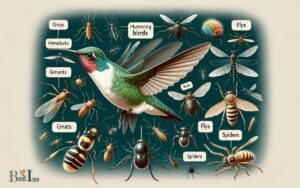Do Male Ruby Throated Hummingbirds Migrate Before Females?
Male ruby-throated hummingbirds typically begin their migration journey earlier than females.
In North America, these males start heading south to their wintering grounds in Central America as early as late July, while females and juveniles often delay their departure until August or September.
Ruby-throated hummingbirds exhibit a migratory pattern where the males lead the way. This is due to several reasons:
Migratory behavior in ruby-throated hummingbirds can be summarized as follows:
- Males migrate first to secure wintering territories.
- Females and juveniles follow, reducing competition.
- The timing correlates with food resource availability.
The early migration of male ruby-throated hummingbirds underscores nature’s complex patterns, where survival hinges on strategic seasonal movements.

Key Takeaway
Ruby-Throated Hummingbird Migration Patterns
The Ruby-throated Hummingbird migration patterns exhibit a distinct seasonal rhythm that is influenced by various environmental factors.
These tiny birds, weighing only a few grams, embark on an incredible journey from their breeding grounds in North America to their wintering grounds in Central America.
The timing of their migration is primarily influenced by photoperiod, or the length of daylight, which triggers hormonal changes, preparing them for the long journey.
Additionally, availability of food sources, weather conditions, and geographic features play crucial roles in shaping their migration patterns.
Understanding these intricate patterns is essential for conservation efforts and ecological research.
Factors Affecting Male Migration Timing
Male Ruby-throated Hummingbird migration timing is influenced by a combination of environmental factors and internal physiological changes.
These factors include:
- Photoperiod: The length of daylight triggers hormonal changes in male hummingbirds, prompting them to prepare for migration.
- Food availability: Male hummingbirds need to build up fat reserves for their long migratory journey, so the availability of nectar-rich flowers plays a crucial role in determining their migration timing.
- Weather conditions: Unfavorable weather, such as strong headwinds, can delay or expedite the migration of male hummingbirds.
- Social cues: Interactions with other hummingbirds, including competition for mates, may influence the timing of male migration.
- Individual health: The overall physical condition of male hummingbirds, including their age and reproductive status, can affect their readiness to migrate.
Breeding Territories and Migration Behavior
Breeding territories and migration behavior in Ruby-throated Hummingbirds reflect complex interactions shaped by environmental and social dynamics.
During breeding season, male hummingbirds establish territories that contain floral resources to attract females and provide food for themselves.
Migration behavior is influenced by the availability of these resources, as well as factors such as photoperiod and weather patterns.
The table below outlines key aspects of breeding territories and migration behavior in Ruby-throated Hummingbirds:
| Aspect | Description |
|---|---|
| Territory Size | Varies based on resource availability and competition with other males |
| Migration Timing | Generally, males arrive at breeding grounds before females to establish territories and attract mates |
| Environmental Influences | Photoperiod, weather patterns, and floral resource availability |
| Social Dynamics | Competition for territories and mates, and communication through vocalizations |
| Conservation Implications | Understanding habitat needs and migration patterns to inform conservation efforts |
Understanding these dynamics is crucial for the conservation of this species and the preservation of their breeding and migratory habitats.
Research Findings on Male-Female Migration Discrepancies
Research findings suggest that there is an observable discrepancy in the migration timing of male and female Ruby-throated Hummingbirds.
Studies have revealed several interesting patterns:
- Male Ruby-throated Hummingbirds typically migrate earlier than females.
- This timing difference may be related to the need for males to establish breeding territories before the arrival of females.
- Research indicates that environmental cues, such as day length and food availability, may play a role in triggering migration for each gender.
- Satellite tracking has shown distinct migration routes for males and females, with males often taking a more direct route to breeding grounds.
- It is hypothesized that these gender-specific migration patterns may be driven by evolutionary and ecological factors.
This discrepancy in migration timing raises questions about the environmental influences on migration schedules for male and female Ruby-throated Hummingbirds.
Environmental Influences on Migration Schedules
One important factor influencing migration schedules for Ruby-throated Hummingbirds is the availability of resources in their wintering and breeding habitats.
The timing of migration is closely linked to the abundance of food sources, such as nectar from flowers and insects, which are crucial for their survival and successful breeding.
Environmental conditions, including temperature and daylight duration, also play a significant role in triggering migratory behavior.
These factors can differ between male and female hummingbirds due to variations in energetic requirements and reproductive strategies.
Additionally, environmental changes, such as deforestation and urbanization, can impact the availability of suitable habitats along their migratory routes, influencing the timing and success of their migrations.
Understanding these environmental influences is critical for the conservation and management of Ruby-throated Hummingbird populations.
Conservation Implications of Migration Timing
The timing of migration in male and female Ruby Throated Hummingbirds has significant conservation implications.
Differences in migration timing may impact breeding success and the distribution of resources within their habitats.
Understanding these implications can inform conservation efforts aimed at preserving suitable breeding grounds and ensuring the availability of essential resources for these hummingbirds.
Breeding Success Impact
Breeding success is influenced by the timing of migration, with potential conservation implications for Ruby Throated Hummingbirds.
The impact of migration timing on breeding success can have significant implications for the population dynamics and conservation of these birds.
Several factors influence breeding success, including:
- Availability of suitable nesting sites and food resources upon arrival at breeding grounds
- Competition for resources and territories with resident and other migratory bird species
- Inclement weather conditions that may affect breeding conditions
- Predation risks and the ability to defend territories and offspring
- Access to high-quality mates and successful mating opportunities
Understanding how migration timing affects breeding success is essential for developing effective conservation strategies to support the long-term viability of Ruby Throated Hummingbird populations.
Resource Distribution Implications
Migration timing of male and female Ruby Throated Hummingbirds has significant implications for resource distribution and conservation efforts.
Understanding the timing of their migration is crucial for managing and conserving their habitats.
As males typically migrate before females, this could potentially impact the availability of resources such as nesting sites, food, and suitable breeding grounds.
This imbalance in resource distribution could lead to increased competition and potentially decrease breeding success.
Conservation efforts should take into account the different timing of migration for males and females to ensure that suitable resources are available throughout the migration period.
By understanding the implications of migration timing on resource distribution, conservation strategies can be tailored to better support the needs of both male and female Ruby Throated Hummingbirds throughout their migration journey and breeding season.
Conclusion
The migration patterns of male and female ruby-throated hummingbirds raise questions about the factors influencing their timing.
More research is needed to understand the environmental cues and breeding territories that drive these differences.
How do these discrepancies in migration behavior impact the survival and conservation of this species?
Understanding the complexities of hummingbird migration will be crucial for developing effective conservation strategies.






